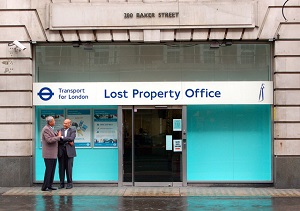You have no items in your cart. Want to get some nice things?
Go shopping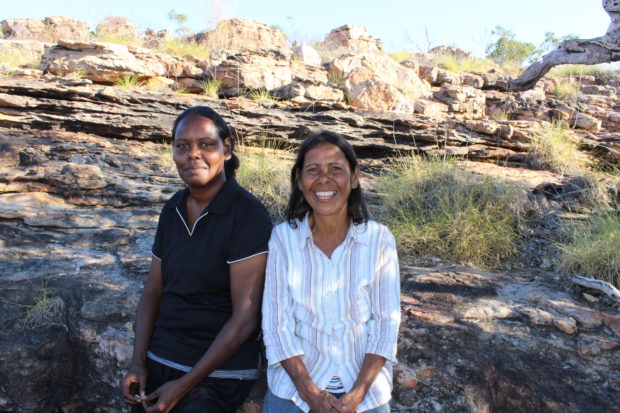
Being in country
I want to tell you about my friend Isobel Peters. On her Lulim estate beach in the far north west of Australia, the Kimberley region, she welcomes me to the land – and sea – inherited through her direct bloodline, via her mother’s father, of 50,000 years. In fact estimates are now as high as 60,000 years.
Let those numbers sink in. When I step into Isobel’s country, with its own language and ways, I join one of the longest continuous cultures on earth, possibly one of the longest continuous cultures in history.
The last of her tribal elders has died, and now, an elder herself, Isobel is the link between them and the next 60,000 years. Visiting her here is described as “being in country”.
When I ask about the boundaries of Lulim, Isobel explains they stretch from Doubtful Bay, northward past Hall Point to the top of Deception Bay, and inland to George Water.
“Also, because of my family, I’m the traditional owner for all these islands and reefs,” she says, pointing out to Montgomery Reef and Islands.
The custodianship of the Montgomery islands, or Yowjab, came via her family tree, deaths and descent before she was born, in the time of her grandfathers and grandmothers. Her relations’ remains are on the islands today.
And there’s more. “There’s other places up north like Augustus Island, which we call Wudugu. Wudugu is also my Aboriginal name.”
Her grandmother Maudie Gaiambiyn never left the land, never wearing Western clothes or eating our food. Isobel visited with her Mum, Amy, just as we all visit our grandparents; regularly spending time in family camps for meals of kangaroo, fish or turtle.
Isobel’s mother Amy was born “in country”, and was described in the 1970s as the last of her people. A respected elder, Amy was also considered an expert linguist, and taught many tribal members their language after they had been moved from country.
Isobel grew up with her mum around the elders of culture, including a renowned woman called Patsy Lalbanda, who was a child when Europeans made their first successful attempt into the country, at the beginning of the twentieth century. Amy referred to Patsy in her tribal relationship as Mum, reflecting a connection up the tribal tree to Patsy’s tribal group, through a grandmother.
Like many of her tribe, the Worrora, Isobel grew up in the town of Derby, where they were relocated in staged removals over half a century. She grew up in the world of English-speaking and Western schools, encouraged at the same time by her elders to learn their traditional ways and lead the tribe back to country.
“When the time was coming,” Isobel tells me, “I said to my Mum How will I survive in country? I don’t remember the language. I was afraid,” she admits. “My Mum said Don’t worry, the birds know the language, just listen to them. It will come back to you. All the animals are your ancestors’ spirits, they will look after you. And it’s true. When I see the animals I look straight at them, like, I know you, I am here with you now.”
This remote country is accessible only by boat or helicopter; the nearest road is hundreds of kilometres away. It’s six hours by boat from the nearest big centre, Derby, or one hour and twenty minutes by helicopter – about as far as is comfortable to fly given it’s a three-hour round trip without refuelling. Because the area is so tidal and fraught by sea, in fact, boat visitors tend to camp en route overnight from Derby. It’s a long trip.
I came by helicopter, landing on the long and narrow red rocks of the beach, sea lapping just feet away, to a place that feels like Peter Pan’s Neverland. I can be here only at Isobel’s invitation; the helicopter pilot needs her permission to land. Lulim being Isobel’s estate, only Isobel can provide this.
She says, “My tribe has a policy now that you can’t just have anyone from the tribe making deals in someone’s country or taking visitors, you have to go with the right people from that area. I fought for that, with my old people supporting me, and now my tribe follows us. Now, a lot of people who were quiet are much prouder and stronger.
“I feel my old people looking at me here. This is one place like the old people are still here, like before this new country [white Australia] took over. I want to preserve that.”
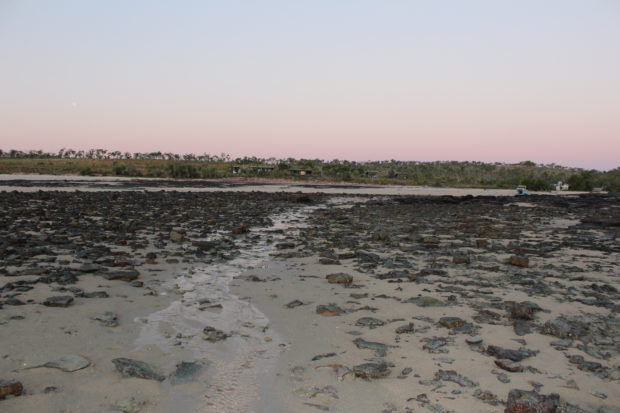
Wungud
Seen through the eyes of Isobel and her family, Lulim teems with activity, all imbued with meaning. Senses and intellect merge; the past, present and future, the physical world and the Dreamtime are experienced simultaneously, without pause. This intense awareness is greater than any you feel in the busiest city.
“It’s Wungud,” Isobel explains. “The life force, the spirit way, all things connected, the birds and animals, us, and the Lalai, the Dreamtime. We can only have it when we are here on our land.”
The name of this beach, where Isobel and her children camp when they’re in country, serves as a fantastic example. Called Freshwater Cove in English, Wijingarra Butt Butt is an action as well as a proper noun. The place name is a reference to a captivating Lalai story.
Wijingarri is one of the greatest Lalai or Dreamtime spirits of this country. Wijingarri, as told by Isobel’s clan, took forms as both a sea- and land-creature, and became the great composer of songs not only for Isobel’s tribe, the Worrora, but also the neighbouring Wunumbul and Ngarinyin tribes – together the three tribes are sometimes called the Wanjina people.
At this beach, he left the sea and took on the form of the Wijingarra, a small marsupial, the northern quoll. Then he shook off the water – butt butt, shake, shake. You can see on a quoll the white marks of the water drops he shook off. The water drops created the unique freshwater pools around the beach. This area has some of the best freshwater drinking holes along the coast.
There is also a story where his spots turn to boils. This marks the seasonal drying and contamination of many pools during the birth and renewal process of Wet and Dry seasons that dominate this part of the world.
Writing this name, rather than saying it, is to automatically remove some depth of meaning. When Isobel says Butt Butt, she shakes her shoulders, one two, “butt butt” just as Wijingarri did, her smile reflecting the impish legacy of the great spirit. This is not a written language, it’s three-dimensional, igniting the senses as well as the mind.
Keeping the mind and senses sharp, to live each moment purposefully, is to stay safe and fed. This country is full of food – fish, turtles, mud crabs, quails, kangaroos, boab nuts, figs, yams and honey.
Isobel’s ancestor spirits are also animals of this landscape and include snakes, spiders, sharks and crocodiles. Wijingarra Butt Butt has two resident crocodiles and a very healthy population of sharks – every day of my visit little reef and mangrove sharks came into the shallows – quickly ending my swim.
“Here in country the creepy crawlies are my relatives.” Isobel laughs. “We don’t kill them, they are an important part of the system. But we’re careful.”
At one point I find a large turtle shell on the beach and bring it back to camp. “Do you think he died of old age?” I ask hopefully.
The family laughs. “No, he was eaten by a shark.”
Liyan
It’s not possible to overstate the relationship between Isobel and her children and the land.
“We call it liyan,” she says. “We feel it here in our stomachs. White people are talking now about how the stomach has a brain. Well we always knew that. When I’m here in country I feel right within myself.
“We call our Dreamtime Lalai. Lalai tells of how the crocodiles and snakes and all the animals came to be here. And I mean right here. They stay here in the same place, in the land of my dreaming. They come back to me and my family.
“Animals and sharks can smell fear and come after you. But I don’t ever smell that way because I know these are my ancestors.
“We have no stories about crocodiles or sharks eating people – and our people always camped by the sea – that’s why we know not to be afraid.
“This country is full of snakes, but I’ve never seen one in camp. Never. They respect me. They don’t bother me.” And to be fair, I didn’t see a snake once in my five days there with Isobel. After I left some Whip snakes did appear in the camp, while relatives of Isobel were visiting, which they say means those people have some connection to those animals.
There’s evidence to support the Dreamtime connection between the land and its species. The inimitable freshwater currents flowing into the sea from Wijingarra Butt Butt support a myriad of sea life. It belongs to one of the last intact tropical marine ecosystems on the planet.
Isobel’s whales
I visited Isobel at one of the most important times in her Dreamtime calendar – when the world’s largest humpback whale population returns from Antarctica to her estate for females to give birth to their calves. The season runs roughly from July to November. I arrived at the peak season of August. From Isobel’s point of view, these are her whales – this is where they are born and nursed.
Certainly, Lulim is the apex of Australia’s west-coast migration. Many whales have been recorded giving birth on the way northward, up to Lulim, but here on Isobel’s estate, this is considered the maternity and the nursery ward.
No surprise then that this country also has Lalai stories connecting the humpback whales, the mundumbun, to the creation of the landscape, and to Isobel’s ancestors.
Seen from the water, the islands and shoreline take the form of whales in various surfacing behaviours. In some places the land formed when a whale rolled, in others you can see the clear shapes of whale backs on the surface, and islands made by the flip of a tail.
Her estate is now in the protected marine environment of Lalang-Garram Marine Park, a pristine marine biosphere. She campaigned for almost fifteen years for a marine reserve protecting her whales and the rest of her sea charges, including three other species of marine turtles, dugong, and numerous species of rays, sharks, fish and crustaceans.
The creation of the park and her role as a founding member is one of the successes Isobel is proud of as a result of her lobbying for many years.
Throughout my visit, I see why this is called the nursery. The whales bring their calves into water off the beaches. Perhaps presenting them to us, passing back and forth, but also, I am told, to train in the shallows. Set operations are repeated, first the mother, then the calf, going over and over the exercise for half an hour or more: lob tailing, leaping out of the water to raise its tail fin and slap it down hard, or spinning or breaching.
While the scientists still postulate, Isobel and her family believe one of the whales’ main activities at this time is to prepare for the return journey, including strengthening weak infants or coaching those having difficulties picking up the social behaviours required to survive as a pod swimming back to Antarctica, with all its perils, including Orca attacks.
Scientists refer to Isobel’s whales with the impersonal title Breeding Group D population – an approach completely alien to Isobel’s family, whose wungud or life force has been intertwined with these whales for millennia.
When you view them behaving like this only a hundred metres from the camp, it’s easy to see why Isobel views the whales so.
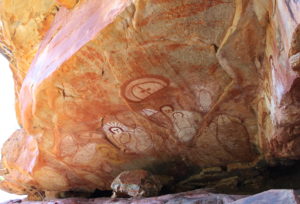
Paleolithic art at Raft Point, part of Isobel’s estate
The elders
It’s a huge responsibility. Over very recent years the last of Isobel’s elders have steadily died; the last of the people who took canoes, even swam from island to island – with no fear of the crocodiles and sharks; who walked inland from Wijingarra Butt Butt to the Gibb River and into Derby.
The grief is difficult enough, having to cope with the death of those you have loved, whose job was to protect you, explain the world and guide you.
But the loss also opens up the reality of the future, the burden on Isobel to respect her elders’ wishes, and protect their land and their ways.
I don’t want to use the word proud because this is applied in such a patronising fashion generally – “a proud people” sounds incredibly condescending.
Isobel is superior – in the best sense of the word. Her confidence, her gravitas, her complete acceptance of the enormity of responsibility for her clan, her devotion to her country and people is on a scale you might imagine of fairy-tale European nobility.
Isobel’s ways are not adopted; they have been inculcated in her from birth.
The elders always told her things like don’t let yourself be turned from laws, or speak for another’s country, don’t forget your tribal relationships, always remember who you are.
“The elders, the munnumburra, told me to be strong,” she says. “They told me to be humble. I spent a lot of time talking with the man I called Daddy (a very important elder called Paddy Neowarra) before he died. He was clear that I had to be able to work with the almara, the foreigners, and also to carry our ways with me. We carry them in our heads. We carry them in our stomachs. This way they can never be lost.
“Our ways are for everyone to share, not just for us Worrora. It’s for everyone. Almara too. We have to live well together.
“And things are getting better. White people are interested in our culture and laws now. The elders would be happy about this.
“When it comes to our ways, we really believe in these things. Everything is mamaa to us – it’s sacred.
“We know that bad things will happen if you go against the proper ways. Like our stories that said heavy rains will flood and destroy everything. All this is true.”
These beliefs are illuminated in the ancient cave art across Isobel’s estate, of which she is custodian. Among the owls, dolphins, whales, fish, her totem spirit the stingray, and other animal images, are cyclones and whirlpools.
The dramatic local tides vary by as much fourteen metres, causing incredible whirlpools and waterfalls offshore around the Montgomery islands or Yowjab.
In this part of the world there is a Dry season – during which I’m visiting – and a Wet season so severe that cyclones are regular visitors, bringing torrential rain and, as I see along the coast, transporting massive trees and turning them into huge logs of driftwood.
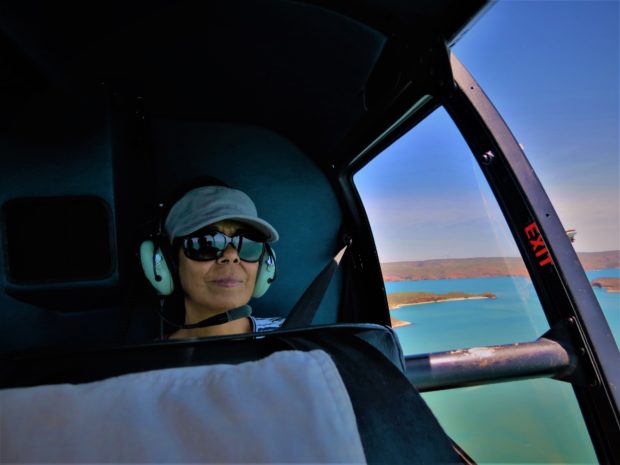
Read Part Two of “Lulim Lalai: The Power of Life In Country” here.
Litro’s mission is to find the best and most exciting new voices in fiction and non-fiction from across the globe and give them a platform for their work. Litro wants to continue to showcase the best emerging artists. You can help us by supporting our Crowdfunder Today!
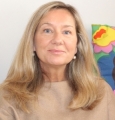
About Lise Colyer
Lise Colyer is a former news reporter who tells stories professionally now in her role as a PR director. She also writes fiction, mainly novels and poetry, and still keeps her journalistic hand in with news stories and non-fiction essays here and there.


